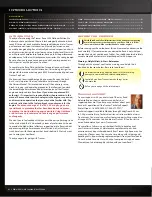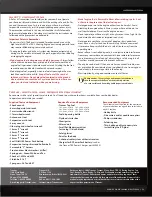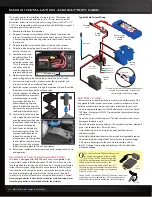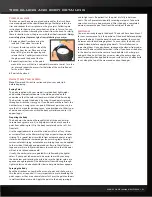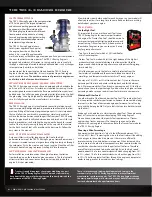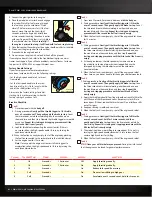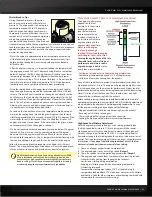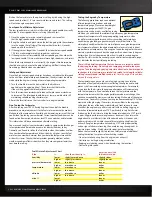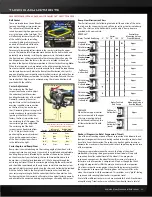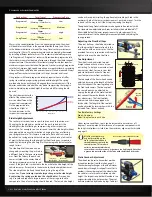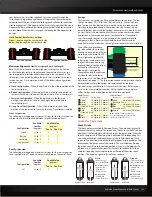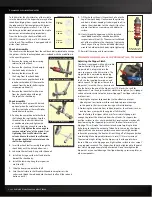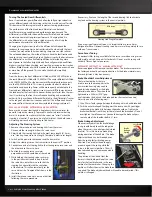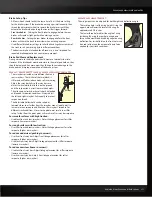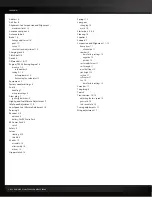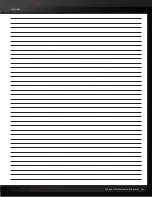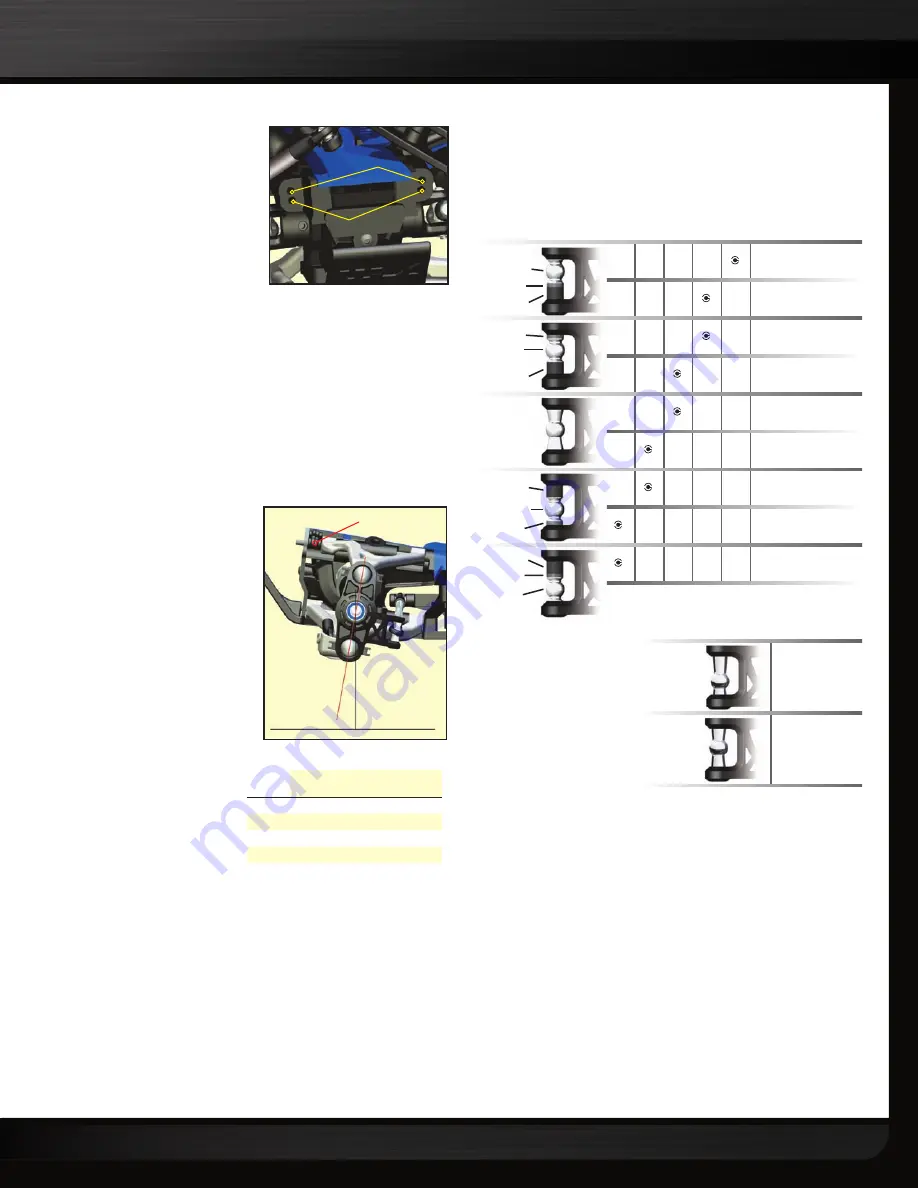
REVO PLATINUM EDITION • 11
TUNING ADJUSTMENTS
Roll Center
There are two holes on the bulkheads
to mount each upper suspension arm.
The roll center of the vehicle can be
raised by mounting the upper control
arm in the lower of the two holes. This
will effectively increase the roll stiffness
of the vehicle (similar to installing
swaybars). Adding roll resistance to
one end of the vehicle will tend to
add traction to the opposite end.
For example, increasing roll resistance in the rear by installing the upper
arms in the lower holes will provide more traction for the front wheels and
potentially more steering. Installing the upper arms in the lower holes on
the front and rear will increase overall roll resistance without changing the
handling balance. From the factory, the arms are installed in the upper
position in the front and the lower position in the rear for track tuning.
Note:
When the suspension arms are moved to the either mounting holes, the
front outer toe link ends and the rear toe control links should be repositioned
to eliminate bump steer. Refer to the Bump Steer Elimination chart on this
page, and look up your suspension combination (caster angle and roll center
position) to find the correct position for the front outer toe links and the rear
toe control links. Adjustment is achieved using the shims and hollow balls
provided with the vehicle.
Caster Adjustment
The caster angle of the front
suspension may be used to adjust
the understeer (push)/oversteer
handling characteristics of the model.
Generally, increasing the caster
angle will move the truck towards an
oversteer condition (more traction
on the front tires, less on the rear
tires). Decreasing the caster angle will
create a tendency towards understeer
(pushing in the turns). From the
factory, the front suspension is set
to a caster angle of 15-degrees. The
rear caster angle is not adjustable.
The caster angle of the front
suspension can be adjusted from
5° to 15°. Adjust the caster by
positioning the caster adjustment
shims on the upper control arms
of the front suspension as shown
in the table to the right.
Caster Angle, and Bump Steer
Bump steer is unwanted change in the steering angle of the wheels as the
suspension travels up and down. It can result in unstable and unpredictable
handling. Bump steer is affected by the position of the outer toe link end
on the axle carrier. From the factory, the toe links are positioned so that
bump steer is virtually eliminated (about 3/100 of a degree through the
entire range of travel). When the caster angle is changed, the outer toe link
end should be repositioned on the axle carrier to maintain zero bump steer
geometry. Adjustment is achieved using the shims and hollow balls provided
with the vehicle. Refer to the Bump Steer Elimination chart and look up
your caster angle setting to find the correct position for the outer toe links.
Positioning the toe-links correctly will maintain the original factory geometry
and eliminate the unwanted steering angle changes caused by bump steer.
Bump Steer Elimination Chart
The illustrations and the following table detail the position of the outer
toe link end for various caster and roll center settings to eliminate bump
steer. The shims and the hollow balls used to adjust bump steer are
provided with your vehicle.
REAR
When the rear upper control
arms are mounted in the upper
of its two mounting holes in
the bulkhead (roll center), the
tall lower hollow ball should
be used.
Rockers (Progressive Rate/ Suspension Travel)
One of the most exciting aspects of Revo’s suspension is the inboard shock
(damper) arrangement that uses pivoting rockers to translate vertical wheel
travel into linear shock motion. The rockers can be changed to increase or
decrease the maximum wheel travel and also to change the progressive rate
of the suspension.
The progressive rate determines how much the force at the wheel
produced by the springs being compressed (wheel force) will vary with
suspension travel (or vertical travel of the wheel). On a progressive
suspension arrangement, the wheel force will increase at a faster and
faster rate as the suspension is compressed. It feels as though the shock
spring gets progressively stiffer the more you compress the suspension.
On a linear suspension arrangement, the wheel force increases linearly as
the suspension is compressed. The spring does not feel any stiffer, even
when the suspension is fully compressed. This provides a very “plush” feeling
suspension with seemingly bottomless suspension travel.
A total of four different rocker arm sets are available for Revo. All rocker arms
except the Long Travel rocker arms will allow the wheel to travel a total of
SUSPENSION AND ALIGNMENT SETTINGS
Caster adjustment shims (4 front, 0 rear)
Vertical
Ground plane
15°
Caster
In Front of
Hinge Pin Boss
Behind Hinge
Pin Boss
5.0°
None
Four
7.5°
One
Three
10.0°
Two
Two
12.5°
Three
One
15.0°
Four
None
Number & Position of Caster Adjustment
Shims (Front Upper Control Arm)
Upper Control Arm
Upper Mounting Holes
Upper Control Arm
Upper Mounting Holes
Upper Control Arm
Lower Mounting Holes
Upper Control Arm
Lower Mounting Holes
Outer Toe Link End Setup
Caster
5° 7.5° 10° 12.5° 15°
Control Arm
Mounting Hole on
Front Bulkhead
Upper
Lower
Upper
Lower
Upper
Lower
Upper
Lower
Upper
Standard
Hollow Ball
Thin Shim
Thick Shim
Thin Shim
Standard
Hollow Ball
Thick Shim
Tall Center
Hollow Ball
Thick Shim
Standard
Hollow Ball
Thin Shim
Thick Shim
Thin Shim
Standard
Hollow Ball
FRONT
Control Arm
Mounting Hole on
Rear Bulkhead
Outer Toe Link
End Setup
Upper
Lower
Tall Center
Hollow Ball
(stock)
Tall Lower
Hollow Ball
5304 Manual Work.indd 11
3/12/08 7:47:37 PM


